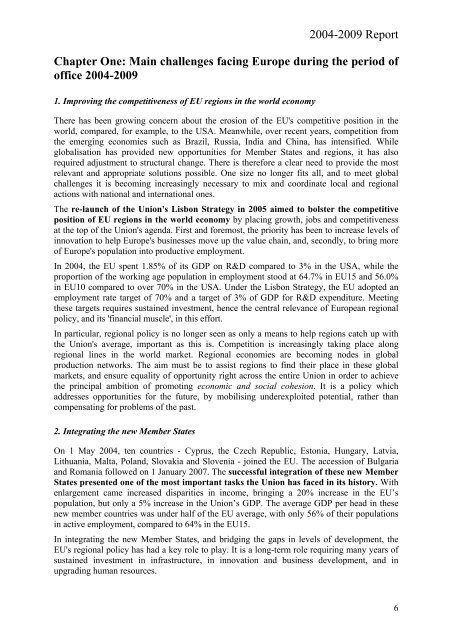Achievements of Europe's regional policy 2004-2009 - Et2050.eu
Achievements of Europe's regional policy 2004-2009 - Et2050.eu
Achievements of Europe's regional policy 2004-2009 - Et2050.eu
Create successful ePaper yourself
Turn your PDF publications into a flip-book with our unique Google optimized e-Paper software.
<strong>2004</strong>-<strong>2009</strong> Report<br />
Chapter One: Main challenges facing Europe during the period <strong>of</strong><br />
<strong>of</strong>fice <strong>2004</strong>-<strong>2009</strong><br />
1. Improving the competitiveness <strong>of</strong> EU regions in the world economy<br />
There has been growing concern about the erosion <strong>of</strong> the EU's competitive position in the<br />
world, compared, for example, to the USA. Meanwhile, over recent years, competition from<br />
the emerging economies such as Brazil, Russia, India and China, has intensified. While<br />
globalisation has provided new opportunities for Member States and regions, it has also<br />
required adjustment to structural change. There is therefore a clear need to provide the most<br />
relevant and appropriate solutions possible. One size no longer fits all, and to meet global<br />
challenges it is becoming increasingly necessary to mix and coordinate local and <strong>regional</strong><br />
actions with national and international ones.<br />
The re-launch <strong>of</strong> the Union's Lisbon Strategy in 2005 aimed to bolster the competitive<br />
position <strong>of</strong> EU regions in the world economy by placing growth, jobs and competitiveness<br />
at the top <strong>of</strong> the Union's agenda. First and foremost, the priority has been to increase levels <strong>of</strong><br />
innovation to help <strong>Europe's</strong> businesses move up the value chain, and, secondly, to bring more<br />
<strong>of</strong> <strong>Europe's</strong> population into productive employment.<br />
In <strong>2004</strong>, the EU spent 1.85% <strong>of</strong> its GDP on R&D compared to 3% in the USA, while the<br />
proportion <strong>of</strong> the working age population in employment stood at 64.7% in EU15 and 56.0%<br />
in EU10 compared to over 70% in the USA. Under the Lisbon Strategy, the EU adopted an<br />
employment rate target <strong>of</strong> 70% and a target <strong>of</strong> 3% <strong>of</strong> GDP for R&D expenditure. Meeting<br />
these targets requires sustained investment, hence the central relevance <strong>of</strong> European <strong>regional</strong><br />
<strong>policy</strong>, and its 'financial muscle', in this effort.<br />
In particular, <strong>regional</strong> <strong>policy</strong> is no longer seen as only a means to help regions catch up with<br />
the Union's average, important as this is. Competition is increasingly taking place along<br />
<strong>regional</strong> lines in the world market. Regional economies are becoming nodes in global<br />
production networks. The aim must be to assist regions to find their place in these global<br />
markets, and ensure equality <strong>of</strong> opportunity right across the entire Union in order to achieve<br />
the principal ambition <strong>of</strong> promoting economic and social cohesion. It is a <strong>policy</strong> which<br />
addresses opportunities for the future, by mobilising underexploited potential, rather than<br />
compensating for problems <strong>of</strong> the past.<br />
2. Integrating the new Member States<br />
On 1 May <strong>2004</strong>, ten countries - Cyprus, the Czech Republic, Estonia, Hungary, Latvia,<br />
Lithuania, Malta, Poland, Slovakia and Slovenia - joined the EU. The accession <strong>of</strong> Bulgaria<br />
and Romania followed on 1 January 2007. The successful integration <strong>of</strong> these new Member<br />
States presented one <strong>of</strong> the most important tasks the Union has faced in its history. With<br />
enlargement came increased disparities in income, bringing a 20% increase in the EU’s<br />
population, but only a 5% increase in the Union’s GDP. The average GDP per head in these<br />
new member countries was under half <strong>of</strong> the EU average, with only 56% <strong>of</strong> their populations<br />
in active employment, compared to 64% in the EU15.<br />
In integrating the new Member States, and bridging the gaps in levels <strong>of</strong> development, the<br />
EU's <strong>regional</strong> <strong>policy</strong> has had a key role to play. It is a long-term role requiring many years <strong>of</strong><br />
sustained investment in infrastructure, in innovation and business development, and in<br />
upgrading human resources.<br />
6







